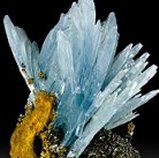
|
| Barites |
Barite means heavy, and it is the heaviest of the non-metallic minerals. Because of its weight, powdered barite was long used by dishonest merchants as a tasteless and odorless additive to flour and sugar. Because it is chemically inert, it is harmless to the human digestive system. In fact, being opaque to X-rays, barite is used in radiology to study the digestive tract. Its ability to absorb radiation also makes barite useful in radiation shields.
Barite (which is also spelled Baryte), which is composed of Barium Sulphate, is a common mineral that is found across the world. It forms "blade" shaped crystals that are usually white or colorless — where influenced by trace quantities of metallic elements, however, these may be blue, green, yellow, or red. Barite is very similar to Celestite, and where there is some doubt, a flame test is the best identification method. Here, a small amount of the mineral is powdered and sprinkled into a naked flame. If this turns green, the sample contains barium, and so the specimen is barite. If it turns red, the colorant is strontium, and so the test piece is Celestite. Barite has a specific gravity of 4.5, a vitreous, pearly or dull luster, and a white streak.
Barite comes in many forms and colors. Some crystals are opaque, some translucent, and some transparent. It may be colorless, blue, white, gray, yellow, or brown. A few are cut for use as gemstones despite the softness of the stone (three on the Mohs scale). Barite includes celestite and like gypsum, barite forms tabular formations commonly referred to as “desert rose.”
A barite desert rose is brownish-rose in color. It will help you realize all possibilities, and it is also ecologically healing. In Native American mythology, it was thought Indian warriors would return at night to carve the barite roses. A scattering of the roses over a vast area indicated an area where they had gathered. The energy of the barite rose is said to increase love, assist covert meetings, and stimulate teamwork.